- Joined
- Sep 17, 2008
- Messages
- 9,390
Its going to be a hurricane so I'm going to call it one now...
I keep seeing a trend west. I wasn't going to even put this out there but some model runs are making some suggestions of a CONUS scrape.
And Lee is on tap to become a major hurricane.
Some model members had it going into North Carolina and riding the coast. Some had it going into New England, riding up the coast. And still some have missing CONUS altogether.
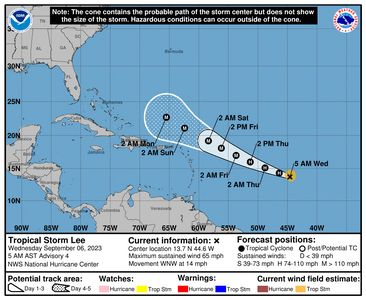
000
WTNT43 KNHC 060837
TCDAT3
Tropical Storm Lee Discussion Number 4
NWS National Hurricane Center Miami FL AL132023
500 AM AST Wed Sep 06 2023
Lee continues to strengthen at a quick pace. Satellite images show
that deep convection has been increasing in intensity and coverage
in a central dense overcast feature and in a sprawling curved band
over the western semicircle. The Dvorak classifications from TAFB
and SAB are now 3.5/55 kt, and accordingly, the initial intensity
has been increased to 55 kt. Lee is not far from hurricane
strength, and it likely will achieve that status later today.
The tropical storm is moving west-northwestward at 14 kt on the
south side of a subtropical ridge over the central Atlantic. This
ridge is expected to persist to the north of Lee during the next
several days, keeping the storm on a west-northwest track through
the remainder of the week and over the weekend. Although the NHC
forecast and the model guidance continue to show Lee passing to the
north of the northern Leeward Islands this weekend, users are
reminded that the details of the track forecast are still uncertain
at those time ranges. For reference, the average NHC forecast track
errors are around 125 and 175 n mi on days 4 and 5, respectively.
The NHC track forecast lies on the southern side of the model
guidance envelope, roughly halfway between the usually most skillful
consensus aids, HCCA and TVCA.
Lee has already been strengthening fairly quickly despite some
east-northeasterly vertical wind shear over the system. Since the
shear is expected to relax while the storm remains over very warm
water and in a moist environment, continued steady to rapid
intensification is expected during the next few days. Most of the
intensity models are very aggressive, bringing Lee to major
hurricane status by the weekend, but they don't show much change in
strength in the short term. In addition, even the global models
like the GFS and ECMWF show explosive intensification and forecast
Lee's minimum pressure to drop by more than 60 mb by the end of the
forecast period. The NHC intensity forecast lies near the high end
of the model guidance during the next 24-48 hours, but falls to near
the middle of the guidance envelope after that. Regardless of the
details, there is high confidence that Lee will be a powerful
hurricane late this week and over the weekend.
KEY MESSAGES:
1. Lee is forecast to become a major hurricane by late this week and
could bring impacts to the Leeward Islands this weekend. While it is
too soon to determine the location and magnitude of these possible
impacts, interests in this area should monitor the progress of Lee
and further updates to the forecast.
FORECAST POSITIONS AND MAX WINDS
INIT 06/0900Z 13.7N 44.6W 55 KT 65 MPH
12H 06/1800Z 14.3N 46.4W 70 KT 80 MPH
24H 07/0600Z 15.1N 48.8W 80 KT 90 MPH
36H 07/1800Z 16.0N 51.3W 90 KT 105 MPH
48H 08/0600Z 17.0N 53.7W 105 KT 120 MPH
60H 08/1800Z 18.1N 56.2W 120 KT 140 MPH
72H 09/0600Z 19.2N 58.4W 130 KT 150 MPH
96H 10/0600Z 21.1N 62.4W 130 KT 150 MPH
120H 11/0600Z 22.7N 65.5W 130 KT 150 MPH
$$
Forecaster Cangialosi
I keep seeing a trend west. I wasn't going to even put this out there but some model runs are making some suggestions of a CONUS scrape.
And Lee is on tap to become a major hurricane.
Some model members had it going into North Carolina and riding the coast. Some had it going into New England, riding up the coast. And still some have missing CONUS altogether.

000
WTNT43 KNHC 060837
TCDAT3
Tropical Storm Lee Discussion Number 4
NWS National Hurricane Center Miami FL AL132023
500 AM AST Wed Sep 06 2023
Lee continues to strengthen at a quick pace. Satellite images show
that deep convection has been increasing in intensity and coverage
in a central dense overcast feature and in a sprawling curved band
over the western semicircle. The Dvorak classifications from TAFB
and SAB are now 3.5/55 kt, and accordingly, the initial intensity
has been increased to 55 kt. Lee is not far from hurricane
strength, and it likely will achieve that status later today.
The tropical storm is moving west-northwestward at 14 kt on the
south side of a subtropical ridge over the central Atlantic. This
ridge is expected to persist to the north of Lee during the next
several days, keeping the storm on a west-northwest track through
the remainder of the week and over the weekend. Although the NHC
forecast and the model guidance continue to show Lee passing to the
north of the northern Leeward Islands this weekend, users are
reminded that the details of the track forecast are still uncertain
at those time ranges. For reference, the average NHC forecast track
errors are around 125 and 175 n mi on days 4 and 5, respectively.
The NHC track forecast lies on the southern side of the model
guidance envelope, roughly halfway between the usually most skillful
consensus aids, HCCA and TVCA.
Lee has already been strengthening fairly quickly despite some
east-northeasterly vertical wind shear over the system. Since the
shear is expected to relax while the storm remains over very warm
water and in a moist environment, continued steady to rapid
intensification is expected during the next few days. Most of the
intensity models are very aggressive, bringing Lee to major
hurricane status by the weekend, but they don't show much change in
strength in the short term. In addition, even the global models
like the GFS and ECMWF show explosive intensification and forecast
Lee's minimum pressure to drop by more than 60 mb by the end of the
forecast period. The NHC intensity forecast lies near the high end
of the model guidance during the next 24-48 hours, but falls to near
the middle of the guidance envelope after that. Regardless of the
details, there is high confidence that Lee will be a powerful
hurricane late this week and over the weekend.
KEY MESSAGES:
1. Lee is forecast to become a major hurricane by late this week and
could bring impacts to the Leeward Islands this weekend. While it is
too soon to determine the location and magnitude of these possible
impacts, interests in this area should monitor the progress of Lee
and further updates to the forecast.
FORECAST POSITIONS AND MAX WINDS
INIT 06/0900Z 13.7N 44.6W 55 KT 65 MPH
12H 06/1800Z 14.3N 46.4W 70 KT 80 MPH
24H 07/0600Z 15.1N 48.8W 80 KT 90 MPH
36H 07/1800Z 16.0N 51.3W 90 KT 105 MPH
48H 08/0600Z 17.0N 53.7W 105 KT 120 MPH
60H 08/1800Z 18.1N 56.2W 120 KT 140 MPH
72H 09/0600Z 19.2N 58.4W 130 KT 150 MPH
96H 10/0600Z 21.1N 62.4W 130 KT 150 MPH
120H 11/0600Z 22.7N 65.5W 130 KT 150 MPH
$$
Forecaster Cangialosi

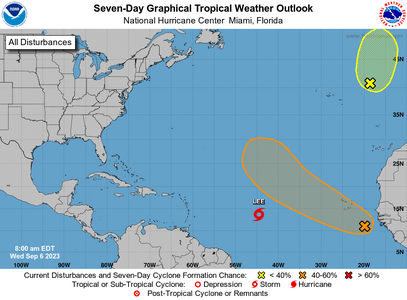
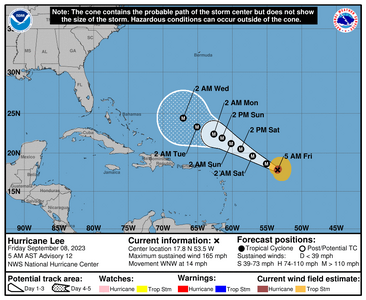
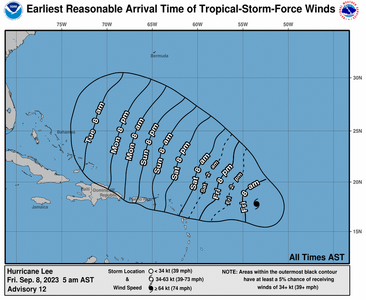

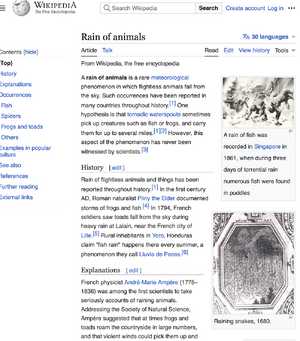
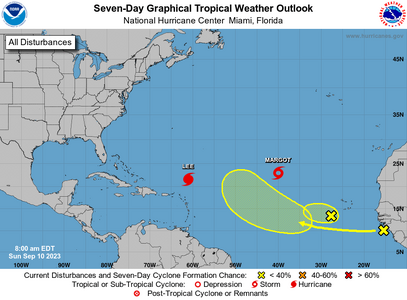
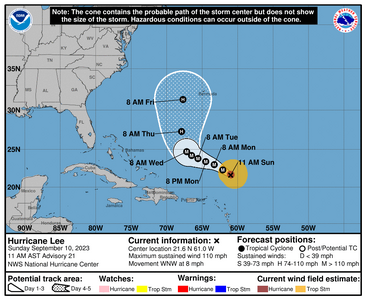
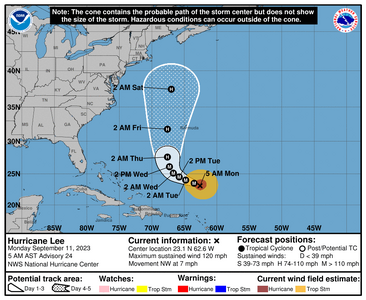
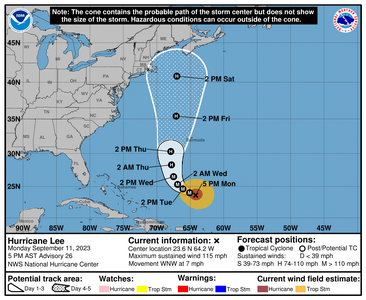
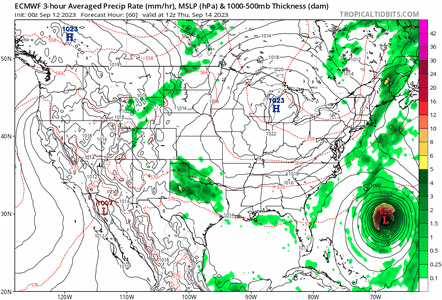
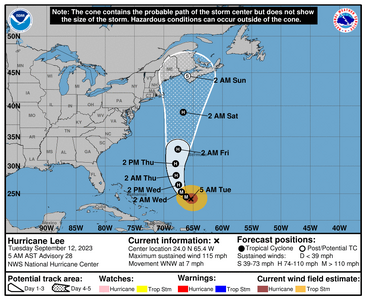
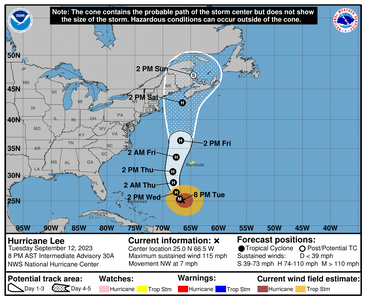
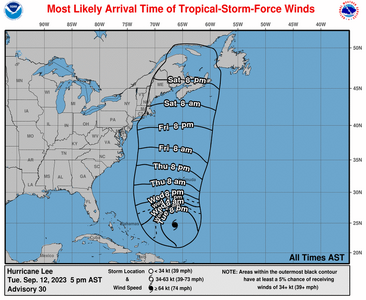
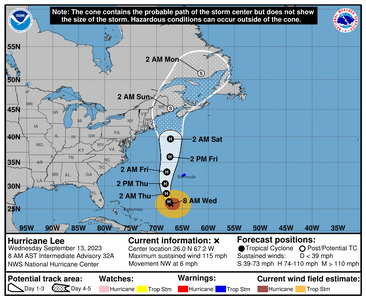


300x240.png)